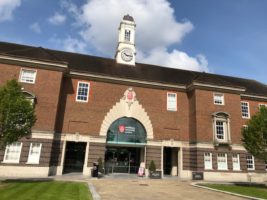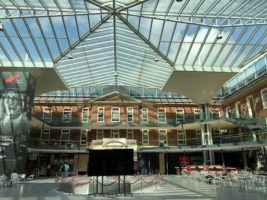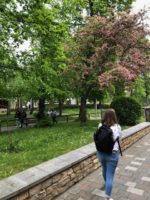London College Tour, Part One by Lessa Scherrer

Imperial College quad and electrical engineering building
I just got back from a weeklong tour of 4 of the 40 colleges and universities in London and can’t wait to tell you all what I’ve learned! The first thing to learn was all the new vocabulary associated with UK higher education. UK universities or “unis” offer many excellent, even world-renowned, majors, here called “programs” or “courses.” Students spend time in “lectures,” “seminars,” or “modules” rather than classes. Sometimes people will refer to studying a course as “reading” it. This is literally true: UK university students spend a much larger portion of their education doing self-study than do US students. Their modules are also more hands-on than a typical US class.

Imperial College residence hall
An excellent example of this is Imperial College, London. Located in the heart of the South Kensington neighborhood, Imperial is a superior, tech-focused university, similar to MIT in the US. Their most popular programs are life and physical sciences, engineering, and technology/gaming. Like most English unis, degrees at Imperial typically take three years to complete versus the more familiar four-year programs at US universities. Imperial has just under 12,000 undergraduates, about 1% of which hail from North America. Imperial College courses are very selective and often expect students to be able to submit 3-4 AP exams with a score of 5. (If you are self-studying for those APs, they may want 4-6 with a score of 5, depending on the course.)

More residence halls, green space
Imperial’s more than 350 societies, sports clubs, and projects provide a supportive environment to help you find your people, including A Cappella groups, American football, basketball, baseball, and softball teams, as well as lacrosse and ice hockey. Students also have access to gym and swimming facilities. Be sure to check out their virtual tour!

Middesex main entrance
Middlesex University is located about 30 minutes from downtown London in the more suburban neighborhood of Hendon, which is easily accessible via the Underground or subway. The campus feels and looks like a US state flagship university, with lots of green space and many specialized buildings. They have a much broader array of available majors as well. Middlesex offers three-year degrees in business/economics, life and physical sciences, fine and performing arts and design, humanities, engineering, technology and gaming, social sciences, health and medicine, and education. Their sports science programs have extensive and amazing new facilities in the StoneX stadium (home of the Saracens professional rugby club). Middlesex also has an awesome performing arts program with dance studios in every building on campus. We saw a hip hop group rehearsing in the picnic area outside the student union, and they were amazing! You can see many of the opportunities available at Middlesex in their virtual tour.

Middlesex atrium
In addition to having a large number of programs, Middlesex is less expensive and less selective than a college like Imperial, which puts it much more within reach for the average US student. Middlesex is test optional for students who have more than a 3.2 GPA. This depends on the program; the more selective programs might also require 2-3 APs with scores of 4, so be sure to check your program. Students with a GPA between 2.8 and 3.1 are required to submit an ACT of 23, an SAT with 550 in each section, or two AP exams with a 3+ to be admitted to Middlesex. They also have fantastic housing for international students, which features single rooms with personal bathrooms and shared kitchens.
In my next post, I’ll describe the tours I took of two additional colleges – Goldsmith’s and Royal Holloway University of London.

Middlesex campus green space

Imperial an urban campus
